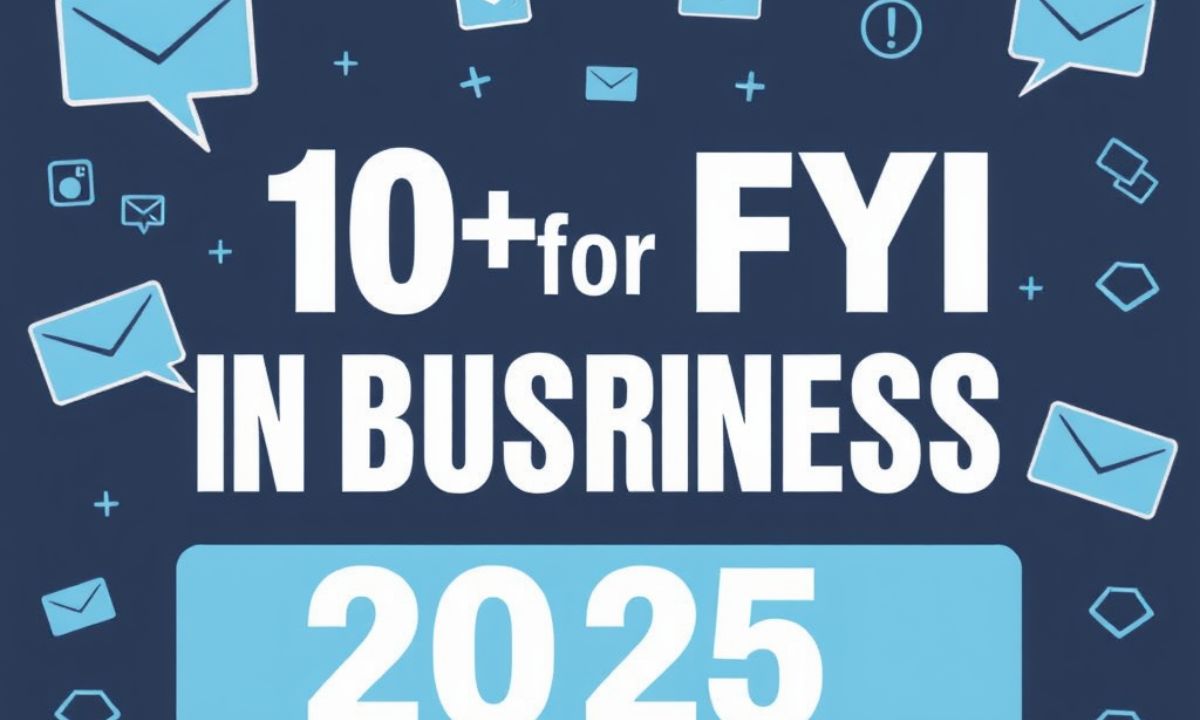Elevating your professional communication requires formal information sharing techniques beyond the standard “FYI” abbreviation.
Discovering effective alternatives enhances workplace communication clarity while maintaining a professional tone in all business correspondence.
These fourteen sophisticated options provide versatile messaging strategies for knowledge updates, ensuring your information dissemination remains polished and appropriate across various professional contexts.
Implementing these alternatives demonstrates communication etiquette expertise, significantly boosting overall business communication effectiveness in any formal setting.
READ MORE: https://travelloverage.com/ways-to-say-more-than-happy-to-help-in-2025/
For Your Information
The phrase “For Your Information” serves as an elegant alternative in formal correspondence, conveying respect while sharing essential knowledge updates.
This professional notification option maintains communication clarity when delivering important details to colleagues or stakeholders.
It creates a professional tone perfect for situations requiring formality without seeming abrupt or casual.
The phrase works exceptionally well in business communication contexts where maintaining professionalism is paramount. When crafting emails or documents requiring information dissemination, this alternative elevates your messaging strategy significantly.
Example: For your information, the quarterly budget meeting has been rescheduled to Thursday at 2 PM.
Heads Up
“Heads Up” functions as a proactive professional notification, alerting recipients to upcoming changes or developments requiring attention.
This casual yet effective phrase maintains workplace communication efficiency while providing advanced warning of potential issues.
When used appropriately, it demonstrates thoughtful communication etiquette by preparing others for upcoming information.
The phrase strikes a balance between formal correspondence and friendly alerting, making it versatile across various business contexts. It effectively signals importance without creating unnecessary alarm, perfect for time-sensitive knowledge updates.
Example: Heads up, the client is requesting an additional meeting before finalizing the contract.
Note
“Note” offers a concise professional alternative for brief information sharing that maintains communication clarity.
This straightforward messaging strategy works effectively for highlighting specific details requiring acknowledgment without elaboration.
The term signals relevant information without demanding immediate action, respecting recipients’ time in professional contexts. Its brevity supports business communication effectiveness, particularly for quick workplace communication needs.
When embedded in emails or documents, it efficiently directs attention to key points requiring awareness.
Example: Note: The new security protocols will take effect starting Monday morning.
Quick Note
“Quick Note” signals brief yet important information dissemination in professional settings without overwhelming recipients.
This messaging strategy acknowledges the value of concise communication while maintaining necessary professional tone.
It effectively prefaces information requiring acknowledgment but not extensive discussion or immediate response.
The phrase respects workplace communication efficiency by signaling brevity and relevance simultaneously. In busy professional environments, it helps prioritize information while maintaining formal correspondence standards.
Example: Quick note: All expense reports must now include digital receipts for faster processing.
Update
“Update” serves as a powerful professional notification indicating new information that revises or enhances previous knowledge.
This alternative excels in project-related communication etiquette, signaling ongoing progress or status changes.
It creates clear expectations about the content following, focusing attention on evolving situations or developments. In workplace communication, it effectively signals continuity while highlighting what has changed or progressed.
The term supports information bulletins where timing and sequencing of knowledge matter significantly.
Example: Update: The development team has completed the first phase of implementation ahead of schedule.
Find More Words!
“Find More Words” encourages collaborative information sharing, inviting recipients to explore additional communication alternatives.
This engaging phrase promotes active participation in knowledge updates rather than passive reception. It creates opportunities for expanding vocabulary and enhancing overall business communication effectiveness.
When seeking input or brainstorming, this phrase signals openness to creative messaging strategies. It works particularly well in training contexts or when developing standardized formal correspondence approaches.
Example: Find more words to describe our product benefits before finalizing the marketing materials.
Informative
“Informative” directly signals educational content delivery, establishing expectations for substantive knowledge updates.
This professional alternative works effectively when providing detailed information requiring careful consideration.
The term establishes communication clarity around the purpose of shared content in formal business contexts.
It supports workplace communication where comprehensive understanding rather than mere awareness matters. When delivering complex professional notifications, this alternative prepares recipients for substantial content.
Example: Informative: This quarter’s performance metrics reveal significant growth in three key markets.
FYA (For Your Awareness)
“FYA” (For Your Awareness) provides a professional acronym alternative that maintains formality while being more contemporary.
This messaging strategy effectively balances efficiency with professional tone in digital business communication.
The phrase signals information requiring acknowledgment without demanding specific action or immediate response. It respects recipients’ autonomy within formal correspondence while ensuring important details aren’t missed.
In workplace communication, it creates appropriate distance while maintaining necessary information dissemination.
Example: “FYA: The IT department will be performing system maintenance Saturday evening.
In the Loop
“In the Loop” emphasizes inclusion in ongoing information sharing, fostering collaborative workplace communication.
This professional notification approach ensures consistent knowledge updates across team members or departments.
It supports transparency in business communication effectiveness by signaling continued information access. The phrase works effectively for ongoing projects requiring consistent awareness of developments or changes.
When maintaining communication clarity across complex initiatives, this alternative ensures no one misses critical updates.
Example: I’ll keep you in the loop regarding the client’s feedback on our initial proposal.”
Sharing
“Sharing” creates a collaborative approach to information dissemination, emphasizing mutual benefit in professional communication. This messaging strategy fosters reciprocity while maintaining necessary formal correspondence standards.
It signals willingness to provide knowledge updates without hierarchical implications often present in directives. In workplace communication,
it supports team cohesion through transparent information exchange practices. The term works effectively in cross-departmental communication where maintaining professional tone matters.
Example: Sharing this market analysis report that contains valuable insights for our upcoming campaign.
Update Alert
“Update Alert” combines urgency with professional notification standards, highlighting time-sensitive information requiring attention. This alternative clearly signals the priority level of the information being shared in business communication.
It supports workplace communication efficiency by helping recipients prioritize their attention appropriately.
The phrase maintains communication clarity around urgency without creating unnecessary alarm or panic. For critical knowledge updates requiring timely awareness, this alternative proves particularly effective.
Example: Update Alert: The client meeting has been moved up to 9 AM tomorrow instead of next week.
Insight
“Insight” elevates routine information sharing by emphasizing valuable perspective or analysis within the content.
This professional alternative signals depth beyond mere facts, offering interpretation or expertise in formal correspondence.
It supports business communication effectiveness by highlighting the added value contained within the shared information.
When providing thought leadership or expert analysis, this term appropriately frames the content that follows. In workplace communication requiring strategic thinking, this alternative emphasizes qualitative value.
Example: Insight: Our competitor’s recent pricing change indicates a shift toward premium market positioning.
Just a Reminder
“Just a Reminder” provides gentle reinforcement of previously shared information, maintaining professional tone without being demanding.
This messaging strategy effectively balances persistence with respect in workplace communication contexts. It acknowledges prior knowledge while recognizing human limitations regarding information retention.
The phrase works well in formal correspondence where ensuring follow-through without micromanagement matters.
In professional communication requiring tactful persistence, this alternative maintains relationship quality.
Example: Just a reminder that all quarterly reports are due by Friday at 5 PM.
Informing
“Informing” establishes a formal notification process, maintaining professional communication standards for official updates.
This alternative works effectively in structured business communication contexts requiring clear documentation. It signals intentionality in knowledge updates while maintaining appropriate distance in professional relationships.
The term supports information dissemination in hierarchical organizations where clear roles matter. When delivering mandated or compliance-related information, this messaging approach maintains necessary formality.
Example: Informing all department heads that the annual compliance training deadline has been extended.
Something to Know
“Something to Know” balances casual accessibility with professional information sharing, creating approachable formal correspondence.
This messaging strategy signals relevant but not urgent knowledge updates in workplace communication. It effectively categorizes information as noteworthy without demanding immediate action or response.
The phrase works well for maintaining ongoing communication clarity without overwhelming recipients. In business communication requiring regular updates, this alternative prevents information fatigue.
Example: Something to know: The new project management software includes additional reporting features.
FAQ’s
How would equivalents to the term “FYI” serve to enrich my professional communication?
Alternative phrases add complexity, convey exact meanings and demonstrate a level of sophistication in communicating, thus helping the recipients understand better the purpose and significance of your message.
What “cultural issues” are associated with the selection of alternatives to “FYI” within global business communications?
Some cultures find it more appealing when it comes to formal and connectivity modes of communication that clearly would prefer alternatives like “For Your Information” as opposed to all casual types of “Heads Up” alternatives in international professional countries.
What is the best” FYI” alternative in urgent information sharing?
“Update Alert” or “Heads Up” most effectively convey urgency while maintaining the professional touch in the cases where time is sensitive and an immediate attention is important.
Conclusion
Adopt new strategies and structures beyond “FYI” when mastering effective communication at work; this will prove to be a valuable asset in increasing workplace effectiveness while at the same time showing mastery in the etiquette of communication.
Bringing these fourteen advanced alternatives into the language of today’s professionals will demonstrate an unmistakably deepened understanding of messaging across many forms and formats-an elevation while ensuring appropriate formality and clarity.
These alternatives not only help to disseminate understanding but show awareness of the audience as well as the corporate environment so that it leans toward better knowledge sharing and a well-developed professional relationship in the modern, complex business world.
The introduction of several professional notifications and formal correspondence techniques offers the organization a strategic edge in today’s environment, where communication quality serves as the foundation for operational success.

I’m Irfan, an experienced SEO content and SEO specialist with 2 years of expertise, currently contributing to Al Jazeera News Website.












